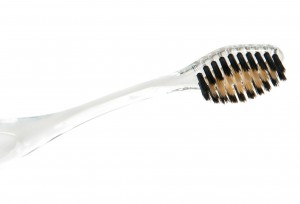This post is sponsored by Nano-b toothbrushes.
Imagine getting up in the morning and sloshing around a bacteria riddled stick in your mouth. It doesn’t sound hygienic, let alone healthy; but this is something most people will do every day. Shortly after you wake up you brush, push and scrub your toothbrush around your teeth, taking a good sample of bacteria from every corner of your mouth, which at the best of times will contain up to 700 species of bacteria1. You then place the now well populated toothbrush back into the toothbrush holder or perhaps on the window sill of the bathroom where it can nicely bake in the sun for 14 or so hours. You know, just to make sure that the bacteria are kept cosy so they can grow really quickly.
You then repeat the procedure in the evening, this time pushing all the bacteria around your mouth, ensuring a large population of bacteria is deposited in every corner of your mouth. You might be scrubbing bits of food away from between your teeth, but you are also causing micro-cuts in your gums, and spreading lots of bacteria around your mouth – a recipe for infection.
A review of 9 individual studies showed that your toothbrush can become contaminated with pathogenic bacteria and viruses from dental plaque, its design and then environment1, and this can lead to health problems. Some of the bacteria isolated from toothbrushes includes Staphylococcus aureus, E. coli, Pseudomonas, and herpes simplex, in large enough quantities to cause an infection2.
How to reduce toothbrush bacteria
To really keep your mouth healthy, you don’t want to be populating it with pathogenic bacteria twice a day, so you need to reduce the bacteria on your toothbrush, which can be done in a few ways:
Storage – Don’t store the toothbrush in a closed container, as this makes growing conditions even better for bacteria. Storing your toothbrush upright and uncovered prevents the growth of bacteria. Ideally, make sure your toothbrush has dried out before your next use.
Rinse – I know this might seem like an obvious thing to do for some people, but you would be surprised. You need to thoroughly rinse your toothbrush before and after use, this means rubbing it with your thumb under the tap and really give it a good clean.
Replace your tooth brush every 2-4 months – I know 2-4 months is a wide scope, but these are based on how well, and frequently you do the above. The generally recommendation is 3-4 months, but if you aren’t taking good care of your toothbrush, you might want to get rid of it sooner.
 Use an antibacterial toothbrush – There are a couple to chose from out there, such as the Nano-b toothbrush. The antibacterial properties of the Nano-b are natural, and use gold or silver to kill bacteria. Both these metals have well documented anti-bacteria properties (particularly against some common pathogens)3,4, and are inert to humans – making them ideal candidates for your toothbrush. In addition to this, they make a toothbrush which includes charcoal, which has a long history of use as a natural teeth cleaning and whitening product5. There is also some anecdotal evidence that charcoal can reduce bad breath, but this is debatable. Still, it makes a great anti-bacterial toothbrush, and the nano-bristles make the brushing process very kind on your gums.
Use an antibacterial toothbrush – There are a couple to chose from out there, such as the Nano-b toothbrush. The antibacterial properties of the Nano-b are natural, and use gold or silver to kill bacteria. Both these metals have well documented anti-bacteria properties (particularly against some common pathogens)3,4, and are inert to humans – making them ideal candidates for your toothbrush. In addition to this, they make a toothbrush which includes charcoal, which has a long history of use as a natural teeth cleaning and whitening product5. There is also some anecdotal evidence that charcoal can reduce bad breath, but this is debatable. Still, it makes a great anti-bacterial toothbrush, and the nano-bristles make the brushing process very kind on your gums.
Disinfect your toothbrush – I don’t mean dip it in bleach, or boil it – this isn’t a good idea for a plastic handled oral tool… You can soak your toothbrush in a mouth wash such as Listerine for 20mins every week or so. This has been shown to effectively reduce bacteria contamination of toothbrushes6. Do make sure you give your give your toothbrush a good rinse afterwards though.
UV sanitisers – You can even get UV toothbrush sanitisers, which have been shown to significantly reduce bacteria population on toothbrushes7.
Worried about oral flora?
You have probably heard about the importance of the gut flora, and how it impacts your health, but this may be the first time you have thought about the oral flora. Whilst it is not as influential on your health as gut flora, it is still important. An imbalance in oral flora can lead to problems such as tooth decay and halitosis (bad breath)8 and if you are repeatedly repopulating your mouth with pathogens in can throw the balance so far out of whack that simply changing your tooth brush won’t fix it.
If this is the case, you may want to consider trying an oral probiotic supplement want to consider trying an oral probiotic supplement which contains a probiotic strain of bacteria called S. salivarius. This probiotic can help re-balance the oral microflora, help protect teeth, and reduce bad halitosis.9
Summary
Through scrubbing your mouth with your toothbrush twice a day, you are opening up an unnecessary route for infection if you do not take precautions to reduce the population of bacteria on your toothbrush. Fortunately, there are a number of simple things you can do to reduce the population of these bacteria – store your toothbrush upright and not in a case, rinse well before and after use and regularly replace your toothbrush. In addition to these, you can buy an anti-bacterial toothbrushes or a UV toothbrush sanitiser.
References
1. Jørn A. Aas. (2005). Defining the Normal Bacterial Flora of the Oral Cavity. J Clin Microbiol.. 43 (11), 5721-5732.
2. Michelle R. Frazelle and Cindy L. Munro, “Toothbrush Contamination: A Review of the Literature,” Nursing Research and Practice, vol. 2012, Article ID 420630, 6 pages, 2012. doi:10.1155/2012/420630
3. Woo Kyung Jung. (2008). Antibacterial Activity and Mechanism of Action of the Silver Ion in Staphylococcus aureus and Escherichia coli. Appl Environ Microbiol. 74 (7), 2171-2178.
4. Yan Zhou. (2012). Antibacterial activities of gold and silver nanoparticles against Escherichia coli and bacillus Calmette-Guérin. J Nanobiotechnology. 10 (9).
5.Ms. Jo Hunter Adams. (2013). The Cultural Basis for Oral Health Practices among Somali Refugees Pre- and Post-Resettlement in Massachusetts. J Health Care Poor Underserved. 24 (4), 1474-1485.
6. Caudry SD. (1995). Contaminated toothbrushes and their disinfection.. J Can Dent Assoc. 61 (6), 511-6.
7. Boylan R. (2008). Reduction in bacterial contamination of toothbrushes using the Violight ultraviolet light activated toothbrush sanitizer.. Am J Dent. 21 (5), 313-7.
8. Iwamoto T. (2010). Effects of probiotic Lactobacillus salivarius WB21 on halitosis and oral health: an open-label pilot trial.. Oral Surg Oral Med Oral Pathol Oral Radiol Endod. 110 (2), 201-8.
9. Wescombe PA. (2012). Developing oral probiotics from Streptococcus salivarius.. Future Microbiol. 7 (12), 1355-71.
Images courtesy of st3f4n and Nano-b.

